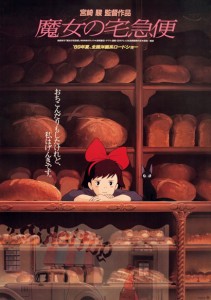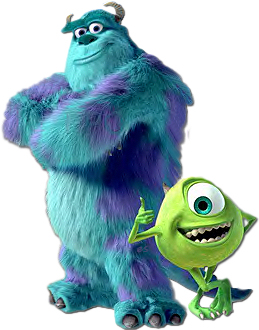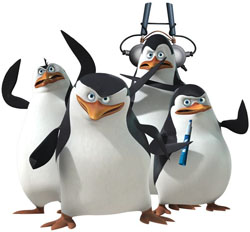
More Than One Way to Dunk Godzilla. From the book “Inside the TV Business (1979) by Paul Klein and Steve Morgenstern, Hanna-Barbera legend Joe Barbera talked about the challenge of staging a dramatic shot and staying in budget:
“You have a budget and you have to stay within it and you have to do footwork, and tricks to come out with an effect. Here’s an example, on a storyboard we had Godzilla fighting a firebird, sort of a pterodactyl type of monster. We staged the scene where Godzilla is clutching his adversary and they fall off screen down into the water. The network wanted to see it from above as a more dramatic shot rather than them sliding off camera and then the next shot is a splash of water.
“To do it as the network wanted would require cutting back to do a longer shot to see them fall. Well that means a lot of drawings of very complicated prehistoric characters and a lot of water animation. You may have seen slow motion films of a drop of water hitting. First it hits, then it begins to come up, and then another drop comes out and then it hits and then it bubbles and then it spreads. That’s eight billion drawings.
“That’s one of the things that gave Disney some of his biggest problems in his time, by the way. He used to think that that was important. Well, we have found out that that isn’t important. I told the network that they should drop off, there would be a tremendous splash and then we would cut to the water bubbling and boiling and steam coming up. That’s still a terrific effect to my way of thinking.”
Rockfish. In 2005 actor Vin Diesel’s film production company, One Race Films, and animation house Blur Studio partnered to build a multi-media franchise around Blur’s RockFish, the multiple award winning 2003 animated short.
The project was envisioned as a CGI feature length, family friendly film based on the character Sirus Kirk from Rockfish that was created by writer/director Tim Miller.
Rockfish was set on a barren planet in a distant corner of the galaxy. Sirus Kirk is a no-nonsense working man tasked with rounding up creatures that “swim” through rocks far below the planet’s surface and plague the miners who live and work there. The story starts out as just another day on the job for Kirk and his little alien pet but quickly turns into a titanic struggle with the catch of his life.
The short came to the attention of Diesel because Blur had done some work for his videogame production company. At the time, there was also talk of making Rockfish into a video game or holding off until the release of the feature.
 The Double Death of Studio Ghibli. Studio Ghibli has released several animated feature film hits but it was on the verge of going out of business twice and not because of financial challenges. In 1989, soon after the release of Kiki’s Delivery Service became a huge hit, director Hayao Miyazaki proposed closing the studio because he believed that one organization could produce maybe three to four classic works before losing its touch and he wanted to quit while he was ahead.
The Double Death of Studio Ghibli. Studio Ghibli has released several animated feature film hits but it was on the verge of going out of business twice and not because of financial challenges. In 1989, soon after the release of Kiki’s Delivery Service became a huge hit, director Hayao Miyazaki proposed closing the studio because he believed that one organization could produce maybe three to four classic works before losing its touch and he wanted to quit while he was ahead.
Producer Toshio Suzuki, who headed Studio Ghibli, convinced Myazaki that it shouldn’t happen because it would be a waste of “a group of geniuses”.
In 1992, Suzuki himself proposed breaking up the studio because of the need to make a huge investment in digitization.
“I don’t think the Japanese creative mind is very suited for 3-D,” stated Miyazaki. “We need to continue because we also have a social responsibility to do 2-D animation.”
“Miyazaki may have said that because there were more films he wanted to make at the studio,” commented a smiling Suzuki.
 Pete Docter’s Secret Origin. In a Chicago Sun-Times article in June 2005, Pixar director Pete Docter revealed “I played violin growing up. I sat through a lot of recitals. You’re nine years old. You’re bored. I ended up drawing in the corners of all the programs, and imagining what would happen if the string broke or if the kettle drum got a hole in it, or just different gags. Today, as I’m animating a scene, I’ll hear it in my head like a piece of music. Often directing animated characters is about setting up a rhythm and breaking it – it’s like a joke. I see no point in trying to just copy real life. You want realism? Get a camera. Much faster, much cheaper.”
Pete Docter’s Secret Origin. In a Chicago Sun-Times article in June 2005, Pixar director Pete Docter revealed “I played violin growing up. I sat through a lot of recitals. You’re nine years old. You’re bored. I ended up drawing in the corners of all the programs, and imagining what would happen if the string broke or if the kettle drum got a hole in it, or just different gags. Today, as I’m animating a scene, I’ll hear it in my head like a piece of music. Often directing animated characters is about setting up a rhythm and breaking it – it’s like a joke. I see no point in trying to just copy real life. You want realism? Get a camera. Much faster, much cheaper.”
Joe Grant. Disney Legend Joe Grant was renowned for his story contributions to Disney animated feature films but he is also credited with coining the title “Monsters Inc.” in 1997 as a parody of the phrase “Murder Inc.” for Pixar. Pete Docter, who directed Monsters Inc., (2001), recalled, “Once when Joe and I were talking over some story concepts, he asked, ‘What are you giving the audience to take home?’ He meant, what part of the story will lodge in the audience’s heart that they’ll remember for days or even years. I think about that every day and I’ll be thinking about him and his advice for a long, long time.”
 The Voice of the Penguin. Tom McGrath was a storyboard artist on Madagascar (2005) and during production got promoted to co-director. He also got another role in the film. He had been voicing the lead penguin, the tough-as-nails Skipper, on the temporary scratch tracks. Everyone liked his performance so much that he was cast in the role because they couldn’t find anyone they liked better. The role had been offered to tough guy actor Robert Stack but he died before production began on the animation.
The Voice of the Penguin. Tom McGrath was a storyboard artist on Madagascar (2005) and during production got promoted to co-director. He also got another role in the film. He had been voicing the lead penguin, the tough-as-nails Skipper, on the temporary scratch tracks. Everyone liked his performance so much that he was cast in the role because they couldn’t find anyone they liked better. The role had been offered to tough guy actor Robert Stack but he died before production began on the animation.
Skipper’s right-hand bird, Kowalski, is played by Chris Miller (Magic Mirror in Shrek’s 1 and 2 and director of Shrek 3). Christopher Knights, an assistant editor plays Private. And, a little know fact is that Rico is voiced –or rather “expressed” –by an uncredited DreamWorks CEO Jeffrey Katzenberg.
“The irony for us is that he’s (Rico) the one who doesn’t talk,” said Madagascar producer Mireille Soria. “There’s something very Dadistic about that, isn’t there?”


 Jim Korkis is an internationally respected animation historian who in recent years has devoted his attention to the many worlds of Disney. He was a columnist for a variety of animation magazines. With his former writing partner, John Cawley, he authored several animation related books including The Encyclopedia of Cartoon Superstars, How to Create Animation, Cartoon Confidential and Get Animated’s Animation Art Buyer’s Guide. He taught animation classes at the Disney Institute in Florida as well as instructing classes on acting and animation history for Disney Feature Animation: Florida.
Jim Korkis is an internationally respected animation historian who in recent years has devoted his attention to the many worlds of Disney. He was a columnist for a variety of animation magazines. With his former writing partner, John Cawley, he authored several animation related books including The Encyclopedia of Cartoon Superstars, How to Create Animation, Cartoon Confidential and Get Animated’s Animation Art Buyer’s Guide. He taught animation classes at the Disney Institute in Florida as well as instructing classes on acting and animation history for Disney Feature Animation: Florida.




















































Somehow I doubt that the network expected him to make eight billion drawings for that fight.
For those curious, the scene in question in “The Firebird” is on youtube in the link below. To give credit where credit is due, Godzilla was one of H-B’s better animated shows, even though in this one the size of the Firebird tends to change from scene to scene. Also, Godzilla visibly smiling is just wrong.
https://youtu.be/dif0AxiNixw?list=PLZs0gQed9tMRSYKXBUfntn5a743ogbx6m&t=1198
Re Joe Barbera and Godzilla; I have the same book discussed here, and nowhere in it does Barbera mention Doug Wildey, the co-producer and chief designer of the show; also of “Jana of the Jungle” which accompanied it on its initial run (and of course, “Jonny Quest” some years earlier.) Doug’s story sensibilities marked all the series with which he was heavily involved; not so much with “Mr. T” and later series which used him as strictly a model-sheet man, and his contributions to Godzilla and Jana were considerable. Of course, he and Joe never did get along too well; reminiscent of Darryl Zanuck’s remark about a certain screenwriter: “Never let that sonofabitch in this studio again unless we need him!!”